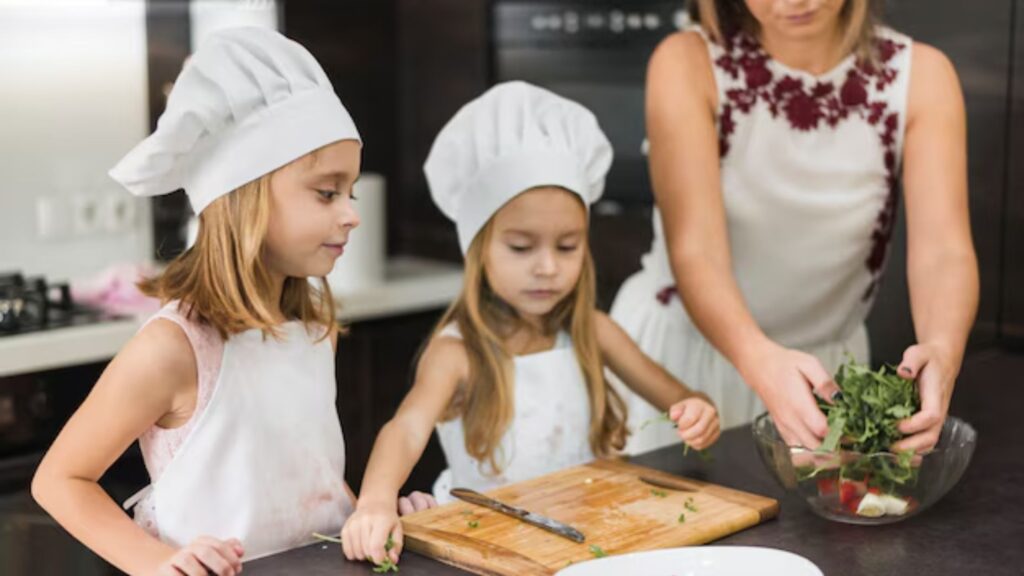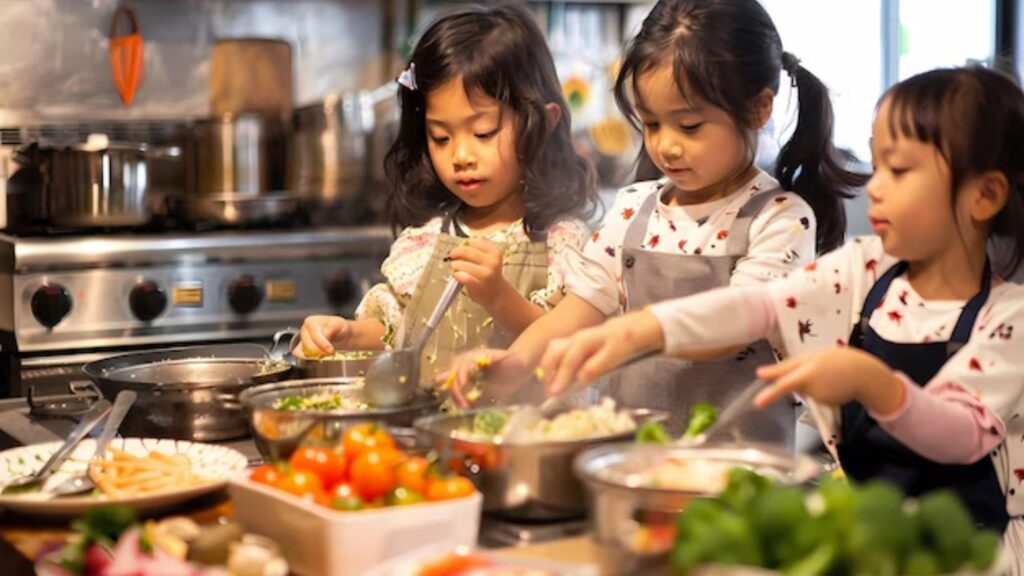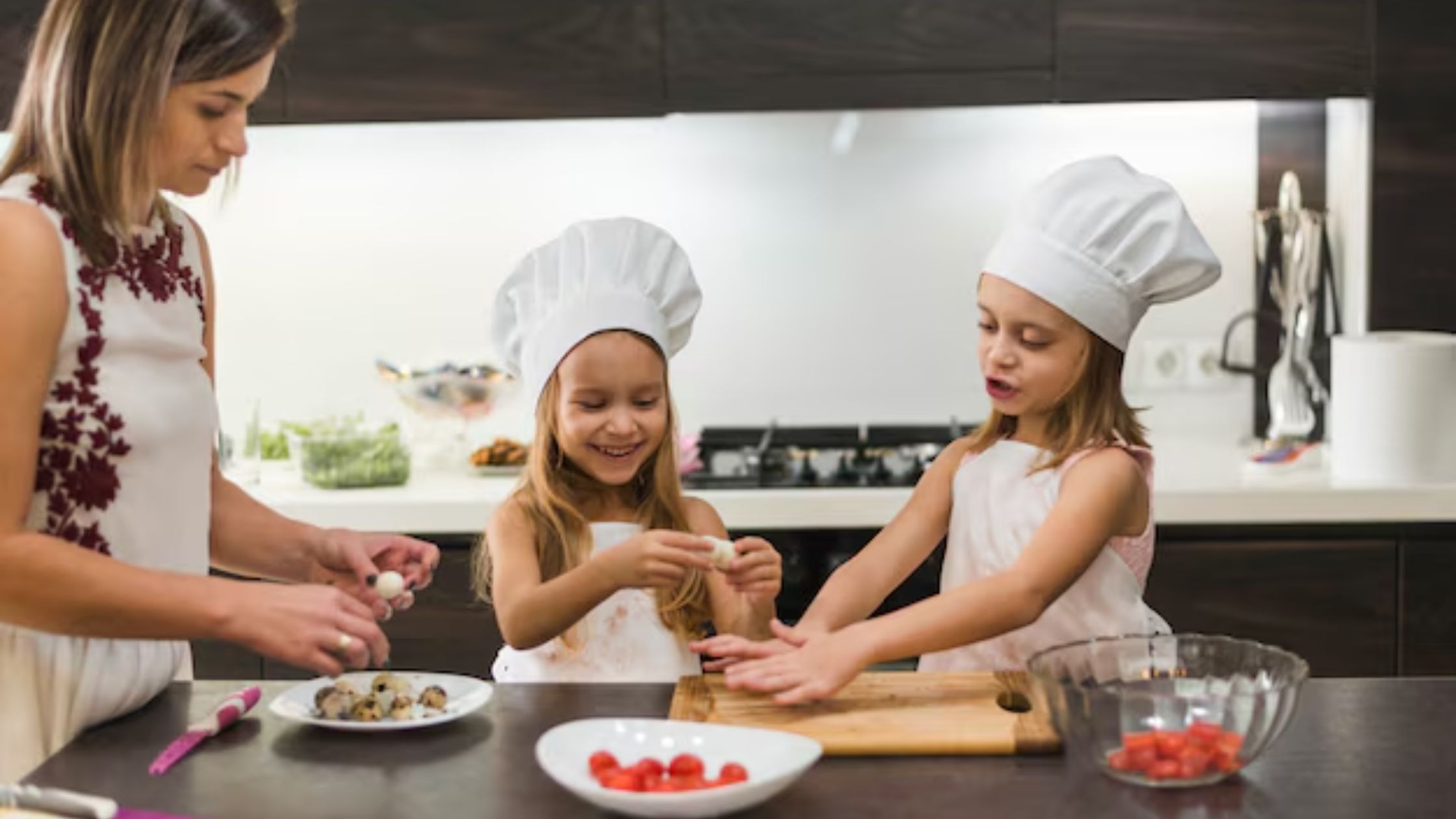Starting a Kids Cooking Class business is a profitable and satisfying venture that combines education and creativity. The business focuses on teaching children important cooking skills, healthy eating habits, and basic culinary techniques, and it is done in an interactive and enjoyable environment. By creating a fun atmosphere, these classes help children develop a love of cooking, as well as learn about nutrition and food preparation.

This Kids Cooking Class Business can be started with a relatively small investment, such as renting a home kitchen or a small, child-friendly space. Investing in basic cooking tools and equipment is necessary, but it can be kept to a minimum so that initial costs are low.
Table of Contents
Effective marketing strategies, such as promotions through social media and local community networks, help attract parents and build a customer base. By providing an engaging and educational cooking experience, this Kids Cooking Class Business generates revenue through class fees and has a positive and lasting impact on children’s eating habits and culinary skills.
1.How to Identify Niche and Target Market for Kids Cooking Class Business
To start a successful kids cooking class business, it is important to first identify your niche and target market. This includes deciding what age group and what interests of children you want to target. For example, you can focus on baking classes for younger children, where they learn simple and fun recipes like cookies and cupcakes. Additionally, you can offer healthy cooking classes, where older children learn to prepare nutritious meals and understand the benefits of a balanced diet. Another option could be international cuisine classes, where children can enjoy and explore cuisines from different cultures.

By defining a clear niche, you can create class content that is tailored to the interests and developmental stages of your target audience. This targeted approach not only makes the classes more engaging and relevant to children, but also attracts parents who are looking for a specific type of culinary experience for their children. Whether your focus is on baking, healthy eating or global cuisine, a well-defined niche ensures that your offering stands out in the market and effectively meets the needs of your target audience.
2.How to Create a Simple Business Plan for Kids Cooking Class Business
Creating a simple business plan is crucial to successfully starting your kids cooking class business. First, determine your main goals, such as how many classes you want to hold per month, the number of students per class, and what specific skills or topics you want to focus on. Clearly defining your objectives will provide a strong foundation for all your business activities and decisions.

Next, detail your target audience. Consider the age group of the children you want to teach, their specific interests, and any dietary preferences or restrictions. This will help you effectively customize your class materials and marketing efforts. For example, if you plan to offer healthy cooking classes, your marketing should highlight the benefits of teaching children about nutrition and healthy eating habits.
Pricing is another important aspect of your business plan. Determine a pricing structure that covers your costs and is also affordable for parents. Research competitors’ pricing so your rates are competitive and sustainable. Consider offering different packages, such as single classes, monthly memberships, or themed workshops, to provide flexibility and attract a wider audience.
Include detailed marketing strategies in your plan. Promote your classes using social media, local community boards, and partnerships with schools or community centers. Offering free introductory classes or discounts for referrals can also help build a client base.
Finally, plan how you will manage and schedule your classes. Outline the frequency and duration of classes, as well as the number of students in each session to ensure the workload is manageable. Make a list of needed equipment and supplies, focusing on the essentials to keep initial costs low. This detailed, yet simple business plan will guide your efforts and help ensure the success of your kids’ cooking class business.
3. Effective use of social media and local networks for kids cooking classes
Promoting your kids cooking classes through social media platforms is an effective way to reach a wider audience. Platforms like Facebook and Instagram offer various tools that help create engaging content, such as posts, stories, and live videos, that can showcase the fun and educational aspects of your classes. Regularly sharing photos and videos of kids attending classes, as well as parent testimonials, can build credibility and attract new students. Running targeted ads on these platforms can also help you reach parents in your local area who may be interested in enrolling their children in cooking classes.

In addition to social media, leveraging local community networks is essential to building a strong customer base. Partner with local schools to include information about your classes in their newsletters or on notice boards. Community centers and libraries often have notice boards or websites where you can post flyers or event announcements. Participating in local events or fairs is also an excellent way to promote your classes. Setting up a booth and offering cooking demonstrations or small workshops can attract attention and give potential customers a chance to experience your classes first-hand.
Offering free workshops or introductory classes can be a highly effective strategy for attracting new students. These sessions give parents and children a glimpse of your teaching style and the activities involved in the classes. By offering the opportunity to try out your classes without obligation, you can allay any concerns parents may have about committing to a full session. These free sessions can also generate word-of-mouth recommendations, as satisfied participants are likely to share their positive experiences with friends and family.
Partnering with local parenting groups can also boost your marketing efforts. Parenting groups often have a strong network of families looking for educational and fun activities for their children. Collaborate with these groups to host events or offer special discounts for their members. These partnerships can give you access to a target audience that is already interested in kid-focused activities, making your marketing efforts more effective.
By combining social media promotion and local community networking, you can create a comprehensive marketing strategy that effectively reaches your target audience and builds a strong local customer base for your kids’ cooking classes.
4.Emphasis on safety and hygiene in kids cooking classes
It is extremely important for kids cooking classes to conduct all activities in a safe and clean environment. Safety and hygiene should be given top priority right from the start. This starts with organizing the kitchen area to minimize hazards, such as keeping sharp objects out of reach of children, keeping the cooking area clean and organized, and having safety equipment like fire extinguishers and first aid kits readily available. Clearly marked instructions and safety guidelines should be visible to remind them of necessary precautions.

Teaching children about kitchen safety and proper hygiene practices is an important part of the curriculum. Start each class with a brief but detailed explanation about the importance of handwashing, using clean utensils, and handling food correctly. It is also essential to teach children how to safely use kitchen tools, such as knives, graters, and hot tools. Emphasize the importance of being aware of their surroundings and maintaining a clean workspace to prevent accidents and ensure food safety. Incorporating these lessons into fun and interactive activities can help children remember and practice these habits consistently.
Focusing on safety and hygiene will not only make parents feel more comfortable, but also establish trust and credibility for your business. Parents will feel reassured knowing that their children are learning in a safe environment where their well-being is prioritized. This type of caring and professional behavior can lead to positive word-of-mouth recommendations and repeat business. In addition, it establishes a strong foundation for your brand, presenting you as a responsible and reliable kids cooking class provider.
Incorporating safety and hygiene practices into your daily operations shows a commitment to the overall health and safety of children. Regularly reviewing and updating your safety protocols ensures that you are always following the highest standards. By prioritizing these aspects, you create a positive and safe learning environment that encourages parents to enroll their children in your classes, confident that they are in safe hands.
5.Effective use of feedback to improve the quality of classes
After each class, it is essential to gather feedback from parents and children to understand what aspects went well and what areas need improvement. This feedback can be collected through simple surveys, comments cards, or informal conversations at the end of the session. Asking specific questions about the course content, teaching methods, and overall experience helps you know how your classes are going. Encouraging honest and constructive feedback creates an open line of communication, so participants feel their opinions are important and heard.
Using the feedback you receive can help you better adapt your classes to meet the needs and preferences of your students and their parents. For example, if parents suggest that the class needs more interactive activities, you can incorporate more hands-on cooking tasks or group projects. Likewise, if children express interest in learning specific recipes or techniques, you can adjust your curriculum to include these elements. Regularly updating and improving your classes based on feedback ensures that your program always remains interesting and relevant.
Introducing new ideas based on feedback and improving the overall experience can significantly increase the success of your kids cooking class business. By constantly evolving your offerings, you show that you are committed to providing a high-quality and enjoyable experience for your students. This progressive approach can lead to higher satisfaction rates, increased word-of-mouth recommendations, and a growing customer base. In addition, it helps your business establish a reputation as one that listens to its customers and strives for excellence.
By following these steps, you can start a successful kids cooking class business with minimal investment and a strong foundation. Getting and acting on regular feedback ensures that your classes stay fresh and engaging, which is key to long-term success. This strategy not only helps meet immediate needs, but also prepares your business for continued growth and development.
6. Investment of ₹20,000 to ₹70,000 to start Kids Cooking Class Business in India: A Simple Guide
Starting a kids cooking class business in India generally requires an investment of ₹20,000 to ₹70,000. This initial investment covers various aspects required to set up the business.
First, the cost of space can vary. If you operate the cooking class from your home kitchen, this expense will be low. However, if you rent a small commercial kitchen or a dedicated space, the cost can range from ₹10,000 to ₹30,000 per month, depending on the location and size. The space must be suitable to safely accommodate children and their cooking activities.

It is also essential to invest in kitchen equipment and supplies. Basic items like child-friendly utensils, mixing bowls, measuring cups, and baking trays are essential to run your cooking class effectively. These basic items usually cost between ₹5,000 to ₹15,000. Additionally, you will also need to budget for ingredients, which can range from ₹2,000 to ₹5,000 per month depending on the frequency of classes and recipes.
Marketing and promotions are also important to attract students and establish your brand. Creating a website, social media advertising, and local promotions may require you to make an initial investment of ₹5,000 to ₹10,000. This budget will help reach potential customers and raise awareness about the cooking classes.
Don’t forget about insurance and licensing as well. Basic liability insurance and any necessary licenses can cost between ₹2,000 to ₹5,000, depending on local regulations. These safety measures ensure that you are covered in case of any unforeseen issues.
Finally, it is a good idea to keep a buffer fund reserved for extra supplies, minor repairs, or decorations. This buffer can range from ₹3,000 to ₹7,000.
Overall, with proper planning and budgeting, you can start a kids cooking class business with an investment of ₹20,000 to ₹70,000. This range accommodates different scales of operations and helps manage the initial cost effectively.
7. Potential profit in kids cooking class business: Monthly income from ₹30,000 to ₹1,00,000
The profit potential of a kids cooking class business depends on several factors. Initially, your income will be affected by how many students you are able to attract and how much you charge per class. Typically, you can charge ₹500 to ₹1,500 per child for a class, depending on how complex the recipes are and the duration of the class. If you manage to consistently fill your classes, your monthly income can increase significantly.
Once your business is established, you can also offer packages or subscription plans, which can provide a steady income source. For example, a monthly package can cost anywhere from ₹2,000 to ₹5,000 per child, depending on the number of classes. If you operate a small class size of 10 to 15 children per session, you can earn ₹20,000 to ₹75,000 per month from just one class. Conducting multiple classes a week or expanding to additional locations can increase your income even further.

Additionally, offering special workshops, seasonal events, or themed classes can attract more students and generate additional revenue. For example, holiday-themed classes or advanced cooking workshops can be offered at a higher price and attract premium fees. Your profit margins can also improve when you build relationships with suppliers, negotiate better rates for ingredients, and effectively manage the cost of operations.
Overall, with proper planning, effective marketing, and a focus on high-quality classes, you can have a profitable business. Many successful businesses in this space report significant returns on their initial investment, and monthly profits can range from ₹30,000 to ₹1,00,000 or more, depending on your scale and business strategies.
Conclusion:
Starting a kids cooking class business is an effective and profitable venture that not only teaches children basic cooking skills but also introduces them to the importance of a healthy diet. This business can be started with low investment, using home kitchens or small spaces and investing in basic equipment. Through effective marketing and by providing a fun, educational environment, you can attract parents and children. Thus, this business not only generates economic benefits but also has a positive impact on children’s food habits and life skills.
If u want to Watch the Video You can visit to our You tube Businovations Channel and watch the video……
Click the link to read the Recent Posts….
Simple steps to start Gift Shop business in India with low investment (150)


Nice post! You have written useful and practical information. Take a look at my web blog ZQ3 I’m sure you’ll find supplementry information about Thai-Massage you can gain new insights from.